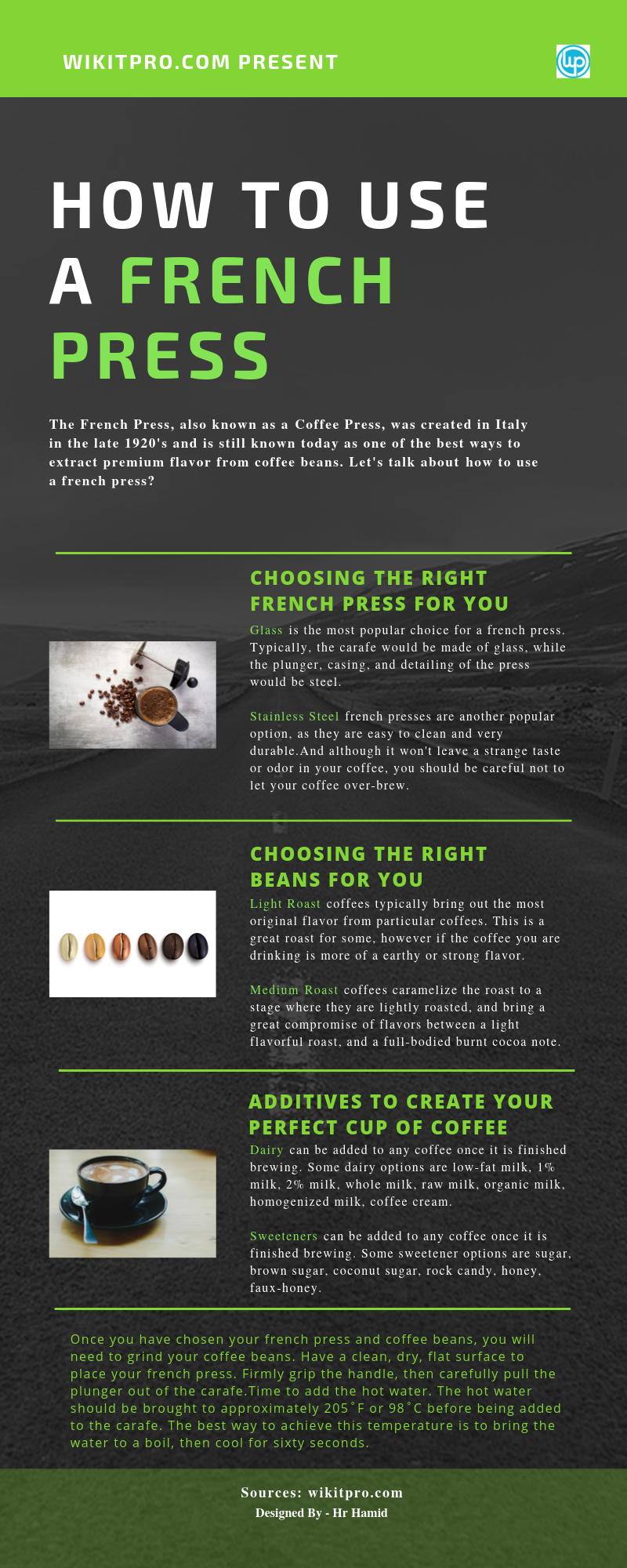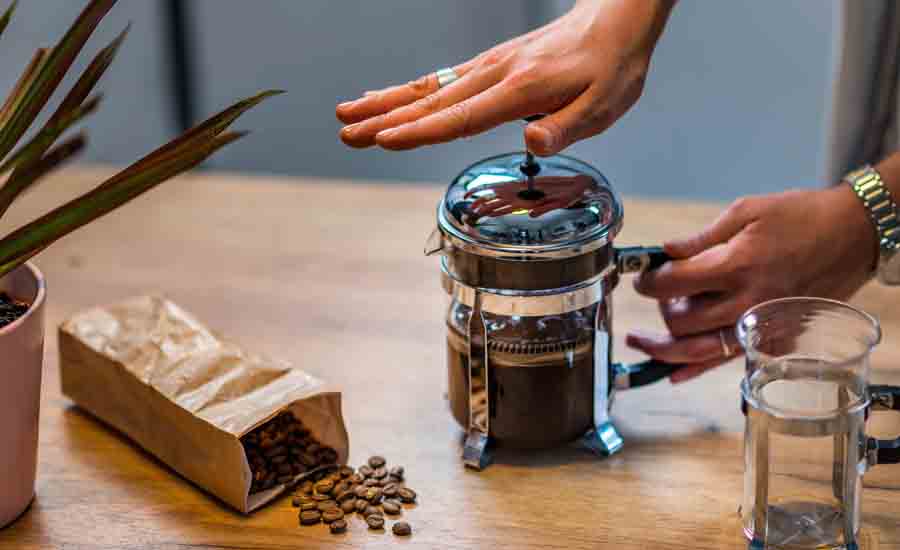How to Use a French Press without trouble
The French Press, also known as a Coffee Press, was created in Italy in the late 1920’s and is still known today as one of the best ways to extract premium flavor from coffee beans. Let’s talk about how to use a french press?
Using a french press may seem intimidating or hard to use, however our team has created a detailed and easy how to use a french press step-by-step tutorial so that you can start french pressing your coffee like a pro. In this tutorial, we will be covering the different types of french presses, the best types of coffee to use with a french press, how the french press functions and how to use a French Press it properly, and how to become a french press expert that is sure to impress anyone.


Here are the things you will need to get started:
- A French Press
- Coffee Beans of your choice
- Hot Water (205˚F / 98˚C)
- optional Cream & Sugar
Choosing The Right French Press For You
There are many different types of french presses to choose from. It’s important that you choose the french press that is going to make the most sense for your personal needs.
Glass
Glass is the most popular choice for a french press. Typically, the carafe would be made of glass, while the plunger, casing, and detailing of the press would be steel. Having a glass french press would allow you to enjoy watching your coffee being freshly pressed, but it is easily breakable and not very durable.
Stainless Steel
Stainless Steel french presses are another popular option, as they are easy to clean and very durable. And although it won’t leave a strange taste or odor in your coffee, you should be careful not to let your coffee over-brew. The stainless steel will keep the water very hot, and if it stays in the carafe for too long, it could cause your coffee to have a strong, bitter taste.
![]()
![]()
Plastic Presses
Plastic Presses are perfect if you are looking for something that is budget-friendly, durable, and shatterproof. Keep in mind that because they are plastic, they may not keep the water steaming hot like other types of presses would.
Ceramic Presses
Ceramic Presses are also a great budget-friendly and durable option. Ceramic presses WILL keep your coffee hot, however because it is ceramic, you won’t be able to watch the process of the coffee being pressed. This can be a deal-breaker for some people.
Choosing The Right Beans For YouJust as it is important to pick which French Press is best for you, it is just as important to pick the right coffee beans that suite your tastes and needs. The french press requires pre-ground beans, and because we aren’t using a paper coffee filter to extract the bean particles, the beans will need to be ground perfectly in order to be soluble enough in hot water.
![]()
![]()
There are thousands of different coffee beans to choose from, and can be found and bought through your local coffee shop, grocery store, or natural foods store. It’s an extremely personal decision to make, so it is easiest if you find out what strength you like best before choosing a flavor. There are three general strengths of coffee to choose from – light roast, medium roast, and dark roast.
Light Roast
Light Roast coffees typically bring out the most original flavor from particular coffees. This is a great roast for some, however if the coffee you are drinking is more of a earthy or strong flavor, light roasts can bring out the quality a little bit too much — creating a bitter or acidic taste. This type of roast is most commonly drank in the early and late morning. This roast’s light, delicate taste is great with foods that compliment it’s flavors such as fruits, yogurt, or bagels — however, because it has fruity and/or acidic notes, it is also great with heavy breakfast type meals such as eggs and bacon, avocados, and other high-fat meal choices.
Medium Roast
Medium Roast coffees caramelize the roast to a stage where they are lightly roasted, and bring a great compromise of flavors between a light flavorful roast, and a full-bodied burnt cocoa note. Medium roasts are best for coffees with fruity or acidic notes such as berries or citrus. This type of roast is most commonly drank throughout the day, from early morning to after dessert. It’s combination and balance of flavors make it a great roast for iced coffees, pick-me-ups, or post-meal finishes that are sure to satisfy your coffee cravings.


Dark Roast
Dark Roast coffees are full-bodied fully roasted beans that are best for chocolate/cocoa dark notes. Typically, you should not dark roast anything with fruity or acidic notes as they have no business in a dark roast. Dark roast is a full caramelization of the brew and is typically associated with dark, rich flavors. This type of roast is most commonly drank in the morning with breakfast or after dessert. It’s rich, wholesome taste is perfect for pairing with sweets and starchy meals such as croissants, chocolate, oatmeal, cake, or pastries.
Espresso
Espresso beans are not optimized for french press usage. Although you technically would be able to use them, the point of an espresso bean is to be roasted with an espresso press that extracts the juices from the bean to create a strong shot of coffee rather than a cup that is diluted by a lot of water like we will be using in the french press. Espresso beans are not typically used for french press purposes. Espresso shots are most commonly drank as a single, double, triple, or quadruple shot over ice, sometimes with milk or cream, or in an Americano which is a single, double, triple, or quadruple shot on ice with a good bit of cold water to create an iced coffee, also sometimes with added milk, cream, sugar, honey, agave syrup, or other sweetener additives or sugar substitutes.
Additives to Create Your Perfect Cup of Coffee
Some people may prefer their coffee black, which means to drink your coffee straight out of the French Press without any added dairy, creamer, or sweetener. However, others may not enjoy the taste of straight coffee as it can be very strong or bitter-tasting to some.
Dairy
Dairy can be added to any coffee once it is finished brewing. Some dairy options are low-fat milk, 1% milk, 2% milk, whole milk, raw milk, organic milk, homogenized milk, coffee cream, whipping cream, or even butter or coconut oil for added fat content. Adding butter or coconut oil to coffee creates a coffee dish that is called “bullet-proof coffee” and is typically used for people who follow Ketogenic or high-fat diets. If you prefer to take a dairy-free approach, there are also specific coffee creamers that have added sweetness and/or flavor that you can buy at your local grocery store that don’t contain any dairy. Other dairy-free options would be coconut milk, soy milk, almond milk, or cashew milk.
Sweeteners
Sweeteners can be added to any coffee once it is finished brewing. Some sweetener options are sugar, brown sugar, coconut sugar, rock candy, honey, faux-honey, agave nectar syrup, maple syrup, organic sugar, stevia, coffee syrups, sugar-free coffee syrups, swerve, sweet-n-low, or Splenda. The dairy-free coffee creamers that we talked about earlier also come in a variety of sweetness levels and flavors that can really add depth in the flavors of your coffee experience.
Other Additives
Other Additives you can pretty much add anything you want to your cup of coffee to make it taste best for your personal preferences. Other popular additives to coffee are raw eggs, whipped cream, chocolate syrup, caramel syrup, strawberry syrup, hot fudge, maraschino cherries, peppermint, candy canes, pumpkin spice, vanilla, toffee, cinnamon, cocoa powder, protein powder, and more. Your cup of coffee should taste how you like it and should be an enjoyable experience all around.
How To Use A French Press

Once you have chosen your french press and coffee beans, you will need to grind your coffee beans. You have this done for you at your local coffee shop upon purchase, and typically grocery stores will have bean grinders available for you to use, otherwise you can grind your beans at home using your own bean grinder.Finding best manual coffee grinder here.
Have a clean, dry, flat surface to place your french press. Firmly grip the handle, then carefully pull the plunger out of the carafe.Time to add the ground coffee beans. Below are the amounts of coffee you should add to the carafe depending on your preferred serving size:
- 2 tablespoons of ground coffee beans
- 1/4 measuring cup of ground coffee beans
- 1/2 measuring cup of ground coffee beans
- 1 measuring cup of ground coffee beans
Measurement of Hot Water
Time to add the hot water. The hot water should be brought to approximately 205˚F or 98˚C before being added to the carafe. The best way to achieve this temperature is to bring the water to a boil, then cool for sixty seconds. Below are the amounts of water you should add to the carafe depending on your preferred serving size:
- 1 measuring cup of hot water
- 2 measuring cups of hot water
- 4 measuring cups of hot water
- 8 measuring cups of hot water
Stir the contents slightly with a stirring stick or clean tablespoon.
the brew for 4 minutes. Remember that if you are using a french press that entraps heat such as a stainless steel or ceramic press, you may need to brew for a shorter period of time depending on the roast of your beans so it doesn’t over-brew and become bitter or sour to taste.
Plunge the press by immediately pressing the plunger down to the very bottom of the carafe.
Pour coffee into desired coffee mug or travel mug and enjoy. French pressed coffee is better tasting when fresh from the press, however you may also add sweeteners or creamers to your coffee for taste such as honey, agave syrup, white or brown sugar, coffee creamer, cream, 2% milk, whipping cream, or anything else you enjoy added to your coffee.
Conclusion
Using a french press is arguably the best way to get the natural, pure flavor out of coffee beans. Be sure to let us know which kind of coffee press you prefer to use and what roast of beans you enjoy the most. If you enjoyed this tutorial and would like to see more, be sure to let us know in the comments section and share this tutorial with your friends and family. You can also view more tutorials how to use a french press like that.
Bonus Tips
3. How To Make Coffee In a Coffee Maker
5. How To Cook Beets In Instant Pot
8. How To Make Coffee With a French Press
9. The Complete Guide Of How To Reheat Pizza 2019

